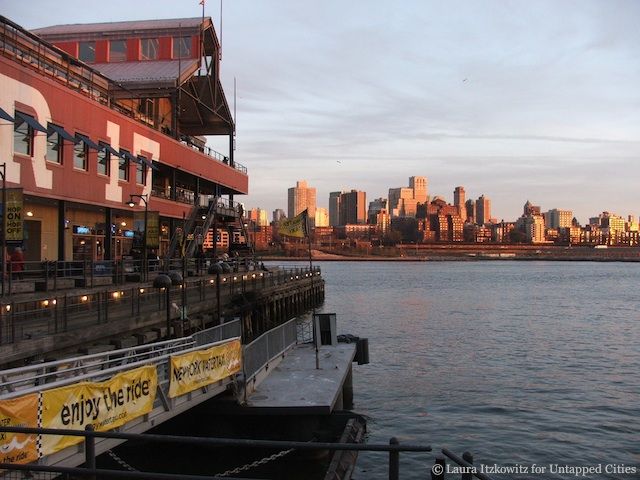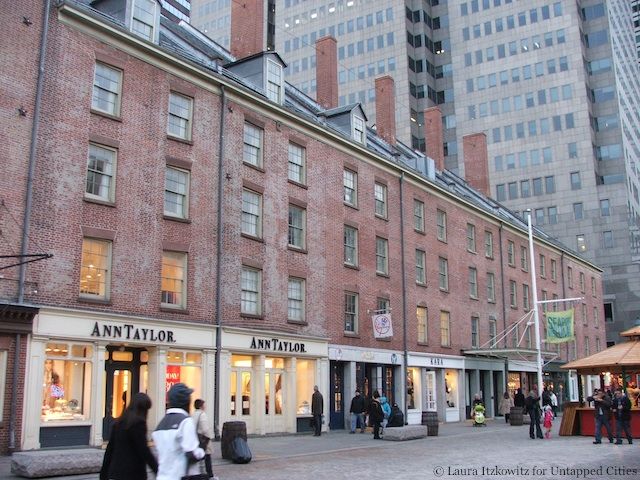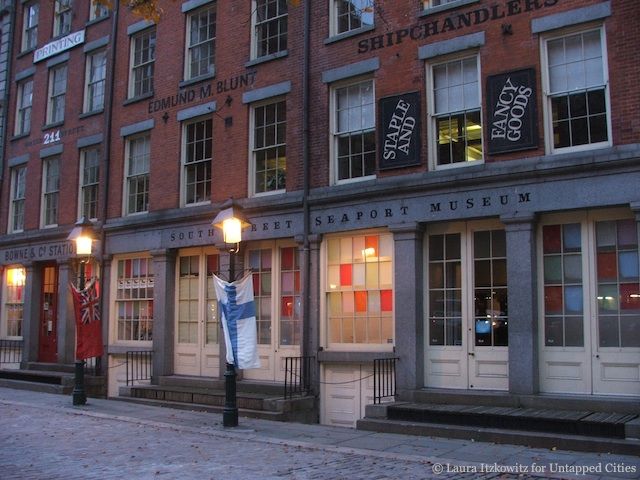Last Chance to Catch NYC's Holiday Notalgia Train
We met the voices of the NYC subway on our nostalgia ride this weekend!


It’s well known that South Street Seaport was one of the most important maritime hubs of New York. Ships have been sailing in and out of lower Manhattan since the days when New York was New Amsterdam, before the United States was an independent country. Lesser known perhaps is the connection of the Schermerhorn family, of New York’e elite, to South Street Seaport. At Untapped, we’re digging into the history and giving you a preview of the new South Street Seaport museum.
 The South Street Seaport today
The South Street Seaport today
In 1719, Gerard Beekman received the first water lot grant east of Pearl Street and built the slip, which is now the South Street Seaport between Fulton and Beekman Streets. Commerce on the seaport grew steadily until the American Revolution, when the British occupied New York Harbor. In 1793, Peter Schermerhorn consolidated Beekman’s water lots, which would later become Fulton Street and Schermerhorn Row.
 Schermerhorn Row on Fulton Street
Schermerhorn Row on Fulton Street
New Yorkers today recognize the name thanks to the Hoyt-Schermerhorn subway stop in Brooklyn, but the Schermerhorn family actually had a great influence on the development of New York City in the 18th and 19th centuries. The Schermerhorn Building, a New York City Landmark, at 376-380 Lafayette Street stands on the original site of the Schermerhorn mansion built in 1888-1889 by Henry J. Hardenbergh, architect of the Plaza Hotel. In 1854, Caroline Webster Schermerhorn married William Backhouse Astor, Jr., the grandson of John Jacob Astor. Caroline epitomized the late 19th-century socialite, as described by Edith Warton and Henry James, throwing lavish parties at her townhouse on Fifth Avenue (the present site of the Empire State Building).
That’s not to say that everything the Schermerhorns touched turned to gold. The seaport was prosperous in the late 19th century, before the Brooklyn Bridge was finished in 1883. At that time, the Fulton Ferry was the main ferry to Brooklyn, and passenger ships destined for every part of the world filled the docks. As it turns out, the Brooklyn Bridge and others constructed along the East River were bad for business, since passengers no longer had to stop at the port. Gradually the port became a working-class area, mostly populated by fishermen and sailors down on their luck. In 1939, the Fulton Ferry Hotel (on the corner of Fulton and South Streets) closed down and the buildings in Schermerhorn Row were abandoned. Joseph Mitchell described the former Fulton Ferry Hotel in an article published in The New Yorker in 1952 (later given the title “Up in the Old Hotel”),
Like the majority of the older buildings in the market district, it is made of hand-molded Hudson River Brick, a rosy-pink and relatively narrow kind that used to be turned out in Haverstraw and other kiln towns on the Hudson and sent down to the city in barges. It has an ornamented cornice and a slate-covered mansard roof. It is one of those handsome, symmetrical old East River waterfront buildings that have been allowed to dilapidate. The windows of its four upper floors have been boarded over for many years, a rain pipe that runs down the front of it is riddled with rust holes, and there are gaps here and there on its mansard where slates have slipped off. In the afternoons, after two or three, when the trading is over and the stands begin to close, some of the slimy, overfed gulls that scavenge in the market roost along its cornice, hunched up and gazing downward.
For Mitchell, the beauty of the place was precisely in its dilapidated quality. The building represented a mystery, the history of its origins covered up like the boarded-up windows that kept the sunlight out of the upper floors. In the essay, he describes his conversations with the proprietor of Sloppy Louie’s, the restaurant on the ground floor. Louie told Mitchell that in 1934, Mrs. Arthur F. Schermerhorn herself came to inquire about the status of the building. She didn’t stay, only looked at the building from inside her chauffeured limousine, but Louie was so impressed he told Mitchell,
“I went back inside and stood there and thought it over, and the effect it had on me, the simple fact my building was an old Schermerhorn building, it may sound foolish, but it pleased me very much. The feeling I had, it connected me with the past. It connected me with Old New York. It connected Sloppy Louie’s Restaurant with Old New York. It made the building look much better to me. Instead of just an old run-down building in the fish market, the way it looked to me before, it had a history to it, connections going back, and I liked that.”

Visitors today can see the buildings restored to their original glory. In 2005, the Fulton Fish Market moved to the Bronx, and in 2011 the Museum of the City of New York took over the management of the South Street Seaport Museum. The museum is currently undergoing renovations, but it will open its doors in January 2012.
The South Street Seaport Museum
12 Fulton Street
New York, NY 10038
(212)748-8600
Get in touch with the author @lauraitzkowitz.
Subscribe to our newsletter